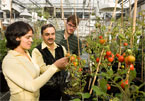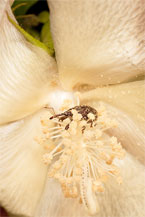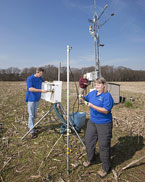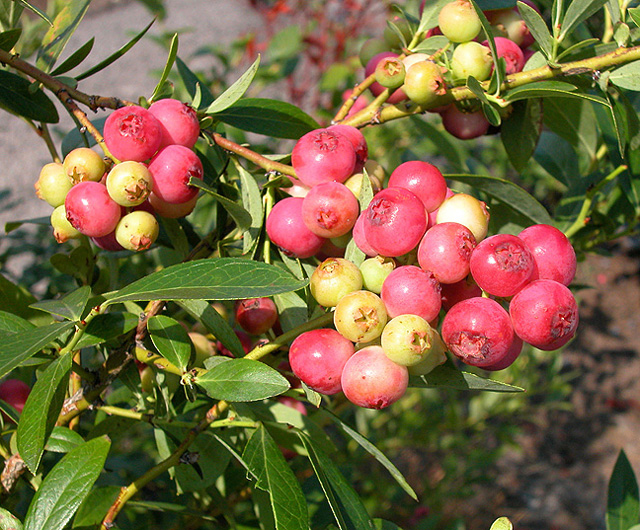Hot Research Topics 2011
Hot Topics Home
2015 | 2014 | 2013 | 2012 | 2011
2010 | 2009 | 2008 | 2007 | 2006
Agricultural Research Service Information Staff's Image Gallery - a complimentary source of high quality digital photographs
Genomics
 Using Genetics To Build a Better Tomato -Agricultural Research Service researchers are working to save our tomatoes-or at least some of them.
Using Genetics To Build a Better Tomato -Agricultural Research Service researchers are working to save our tomatoes-or at least some of them.
Tomatoes spend so much time on shelves and in refrigerators that an estimated 20 percent are lost to spoilage, according to the USDA Economic Research Service. Autar Mattoo, an ARS plant physiologist with the Sustainable Agricultural Systems Laboratory in Beltsville, Maryland, is trying to change that. Mattoo is working with Avtar Handa, a professor of horticulture at Purdue University, to enhance tomatoes so that they offer not only better taste and higher nutrient levels, but also a longer shelf life.
Agricultural Research magazine, Feburary 2011 Complete Article
Insect Pests
 Innovative Ways To Fight Insect Pests - If left uncontrolled, insect pests would eat or ruin about half of all crops grown in the United States. Insects and ticks that bite livestock cause discomfort, reduce production efficiency, and transmit important diseases like bluetongue and equine piroplasmosis. Biting pests are a threat to public health because they can transmit malaria, dengue, chikungunya, West Nile virus, and more.
Innovative Ways To Fight Insect Pests - If left uncontrolled, insect pests would eat or ruin about half of all crops grown in the United States. Insects and ticks that bite livestock cause discomfort, reduce production efficiency, and transmit important diseases like bluetongue and equine piroplasmosis. Biting pests are a threat to public health because they can transmit malaria, dengue, chikungunya, West Nile virus, and more.
New insecticides are constantly needed for all uses-crops, livestock, and public health-but companies tend to produce more new active ingredients for crops than for public health and livestock products, which have smaller markets and are more difficult to develop.
Agricultural Research magazine, January 2011 Complete Article
 Getting Closer to Better Biocontrol for Garden Pests - Agricultural Research Service scientists are moving closer to developing an environmentally friendly bacteria-based biocontrol agent that offers long-lasting protection against caterpillars and other pests in a garden or cultivated field.
Getting Closer to Better Biocontrol for Garden Pests - Agricultural Research Service scientists are moving closer to developing an environmentally friendly bacteria-based biocontrol agent that offers long-lasting protection against caterpillars and other pests in a garden or cultivated field.
Bacillus thuringiensis (Bt) is now used to control gypsy moths, tent caterpillars, leaf rollers, canker worms, and other pests that attack garden plants, corn, and other crops. But the commonly used strain, B. thuringiensis kurstaki, doesn't survive more than one generation.After an initial round of pests is killed, the biocontrol dies out and the pests return.
Agricultural Research magazine, March 2011 Complete Article
Chesapeake Bay
 Federal Forests Still Protecting Chesapeake Bay After 100 Years - For 100 years, the Henry A. Wallace Beltsville Agricultural Research Center (BARC) in Beltsville, Maryland, has maintained and protected its share of 25,660 acres of green space just 15 miles from the nation's capital.
Federal Forests Still Protecting Chesapeake Bay After 100 Years - For 100 years, the Henry A. Wallace Beltsville Agricultural Research Center (BARC) in Beltsville, Maryland, has maintained and protected its share of 25,660 acres of green space just 15 miles from the nation's capital.
The expanse of green space, sometimes called the "Green Wedge," owes its existence to the fact that most of it has been in federal hands since before 1940. BARC was the first federal landowner, beginning with about 500 acres in 1910.
A 2009 Executive order on the Chesapeake Bay-calling for increased cooperation between federal, state, and local agencies and organizations-finds BARC once again at the forefront of environmentally and fiscally responsible cooperative land-use decisions affecting this vast open space.
Agricultural Research magazine, February 2011 Complete Article
 At ARS, the Atmosphere Is Right for Air Emissions Studies -"Air doesn't have any boundaries," says Agricultural Research Service (ARS) chemist Laura McConnell. "So when we study the dynamics of different components that affect air quality, we're trying to figure it out in an open system. For instance, maybe the compound we're studying comes from a local source-or maybe it's coming from a hundred miles away."
At ARS, the Atmosphere Is Right for Air Emissions Studies -"Air doesn't have any boundaries," says Agricultural Research Service (ARS) chemist Laura McConnell. "So when we study the dynamics of different components that affect air quality, we're trying to figure it out in an open system. For instance, maybe the compound we're studying comes from a local source-or maybe it's coming from a hundred miles away."
"This kind of research is a real challenge," agrees Charlie Walthall, who is the national program leader for ARS's work on air emissions. "But there is a substantial payoff for farmers and for the public. We are working to develop management practices that increase the efficiency of agricultural production and that also protect and enhance our soil, water, and air."
Agricultural Research magazine, July 2011 Complete Article
Water Quality
 E. coli: Alive and Well, Probably in a Streambed Near You - Escherichia coli is a survivor. It's at home in the gut of mammals and other vertebrates, but it can also live in soil and water and in biofilms that can form on some moist surfaces.
E. coli: Alive and Well, Probably in a Streambed Near You - Escherichia coli is a survivor. It's at home in the gut of mammals and other vertebrates, but it can also live in soil and water and in biofilms that can form on some moist surfaces.
Another spot where many strains of E. coli lurk is in streambed sediments. Pachepsky is conducting studies with microbiologist Daniel Shelton and other scientists at the ARS Environmental Microbial and Food Safety Laboratory in Beltsville, Maryland, to learn more about where the pathogens in streambeds come from, where they end up, and how long they can survive.
Agricultural Research magazine, July 2011 Complete Article
Food Safety/Security
 ARS Scientists Study the Ins and Outs of E. coli Contamination - Hundreds of strains of Escherichia coli exist, including strains in the human gut that are essential to digestion. Only a few types, like E. coli O157:H7, cause foodborne illness. But food safety experts know it's possible for some of these pathogenic strains to survive in the environment and contaminate leafy greens that are grown in contaminated soil.
ARS Scientists Study the Ins and Outs of E. coli Contamination - Hundreds of strains of Escherichia coli exist, including strains in the human gut that are essential to digestion. Only a few types, like E. coli O157:H7, cause foodborne illness. But food safety experts know it's possible for some of these pathogenic strains to survive in the environment and contaminate leafy greens that are grown in contaminated soil.
Although levels of E. coli microbes can potentially be controlled on the outsides of raw produce, there is concern that plant roots could take in the pathogens along with nutrients and water. This could allow the bacterium to infiltrate the plant's internal vascular system and increase the incidence of foodborne illness.
A 2009 Executive order on the Chesapeake Bay-calling for increased cooperation between federal, state, and local agencies and organizations-finds BARC once again at the forefront of environmentally and fiscally responsible cooperative land-use decisions affecting this vast open space.
Agricultural Research magazine, April 2011 Complete Article
Crop Diversity
 The Delightful Domesticated American Blueberry: Some Research Challenges For Its Next 100 Years - As their millions of fans around the country will happily tell you, America's blueberries are delicious and good for you.
The Delightful Domesticated American Blueberry: Some Research Challenges For Its Next 100 Years - As their millions of fans around the country will happily tell you, America's blueberries are delicious and good for you.
There are many unseen steps in the journey of this popular berry as it makes its way from growers' fields to you. For every major region in which commercial blueberries are grown, Agricultural Research Service blueberry researchers provide new scientific findings to help smooth this journey.
Agricultural Research magazine, May 2011 Complete Article
Nutrition
 Market Lighting Affects Nutrients - Many people reach toward the back of the fresh-produce shelf to find the freshest salad greens with the latest expiration dates. But a new study led by Agricultural Research Service scientists may prompt consumers to instead look for packages that receive the greatest exposure to light-usually those found closest to the front.
Market Lighting Affects Nutrients - Many people reach toward the back of the fresh-produce shelf to find the freshest salad greens with the latest expiration dates. But a new study led by Agricultural Research Service scientists may prompt consumers to instead look for packages that receive the greatest exposure to light-usually those found closest to the front.
The study was led by postharvest plant physiologist Gene Lester while in ARS's Crop Quality and Fruit Insects Research Unit, in Weslaco, Texas. Lester and colleagues Donald Makus and Mark Hodges found that spinach leaves exposed to continuous light during storage were, overall, more nutritionally dense than leaves exposed to continuous dark. Lester is now with the USDA-ARS Food Quality Laboratory in Beltsville, Maryland.
Agricultural Research magazine, May 2011 Complete Article
